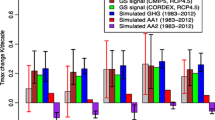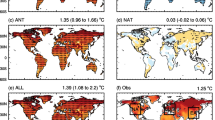Abstract
Using three models from the Coupled Model Intercomparison Project Phase 5 (CMIP5), we compare the direct and other effects of anthropogenic aerosols on observed and simulated annual, winter, and summer temperature changes. Three regions, namely, arid–semiarid area, humid–semiarid area, and the whole of China, are studied. The temperature changes caused by other effects of anthropogenic aerosol (OE) are calculated from the difference between the anthropogenic aerosol forcing run (AA) and the anthropogenic aerosol direct effect forcing run (DE). When the combined effects are considered, a significant area-averaged cooling rate varies in the range of −0.86 to −0.76 °C per century throughout China. Meanwhile, the isolated direct and other effects lower the temperature nationwide by −0.66 to −0.55 °C per century, and −0.31 to −0.11 °C per century, respectively. From a nonlinear perspective, the aerosol-induced temperature experiences a cooling trend, with AA having the largest cooling trend changes both annually and in the summer, while DE has the greatest reduction in the winter. Additionally, the influence of OE cannot be detected in observed annual changes over the arid–semiarid area and the whole of China, while the others are clearly detectable in all cases. AA (DE, OE) reduces the observational temperature mainly over the humid–semihumid region, where the contribution to the observed warming ranges from −515.2 % (−298.7 %, −198.9 %) to −173.6 % (−130.3 %, −66.4 %).





Similar content being viewed by others
References
Allen MR, Stott PA (2003) Estimating signal amplitudes in optimal fingerprinting, part I: theory. Clim Dyn 21:477–491
Charlson RJ, Schwartz SE, Hales JM et al (1992) Climate forcing by anthropogenic aerosols. Science 255:423–430
Che HZ, Shi GY, Zhang XY et al (2005) Analysis of 40 years of solar radiation data from China, 1961–2000. Geophys Res Lett 32:L06803
Cox PM, Betts RA, Jones CD et al (2000) Acceleration of global warming due to carbon-cycle feedbacks in a coupled climate model. Nature 408:184–187
Flanner MG, Zender CS, Randerson JT et al (2007) Present-day climate forcing and response from black carbon in snow. J Geophys Res 112:D11202
Forster P, Ramaswamy V, Artaxo P et al (2007) Changes in atmospheric constituents and in radiative forcing. In: Solomon S, Qin D, Manning M, Chen Z, Marquis M, Averyt KB, Tignor M, Miller HL (eds) Climate change 2007: the physical science basis contribution of working group I to the fourth assessment report of the Intergovernmental Panel on Climate Change. Cambridge University Press, Cambridge
Giorgi F, Bi XQ, Qian Y (2002) Direct radiative forcing and regional climatic effects of anthropogenic aerosols over East Asia: a regional coupled climate-chemistry/aerosol model study. J Geophys Res 107(D20):4439
Giorgi F, Bi XQ, Qian Y (2003) Indirect vs. direct effects of anthropogenic sulfate on the climate of East Asia as simulated with a regional coupled climate-chemistry/aerosol model. Clim Chang 58:345–376
Guo X, Fu D, Guo X et al (2014) A case study of aerosol impacts on summer convective clouds and precipitation over Northern China. Atmos Res 142:142–157
Hall A, Qu X (2006) Using the current seasonal cycle to constrain snow albedo feedback in future climate change. Geophys Res Lett 33:L03502
Hansen J, Nazarenko L (2004) BC climate forcing via snow and ice albedos. Proc Natl Acad Sci 101:423–428
Harris I, Jones PD, Osborn TJ et al (2014) Updated high-resolution grids of monthly climatic observations—the CRU TS3.10 dataset. Int J Climatol 34:623–642
Haywood JM, Boucher O (2000) Estimates of the direct and indirect radiative forcing due to tropospheric aerosol: a review. Rev Geophys 38:513–543
Haywood JM, Francis P, Dubovik O et al (2003) Comparison of aerosol size distributions, radiative properties, and optical depths determined by aircraft observations and Sun photometers during SAFARI 2000. J Geophys Res 108(D13):8471
Huang NE, Wu Z (2008) A review on Hilbert–Huang transform: method and its applications to geophysical studies. Rev Geophys 46:RG2006
Huang Y, Dickinson RE, Chameides WL (2006) Impact of aerosol indirect effect on surface temperature over East Asia. Proc Natl Acad Sci U S A 103:4371–4376
Huang J, Guan X, Ji F (2012) Enhanced cold-season warming in semi-arid regions. Atmos Chem Phys 12:5391–5398
Jacobson MZ (2004) Climate response of fossil fuel and biofuel BC, accounting for BC’s feedback to snow and sea ice albedo and emissivity. J Geophys Res 109:D21201
Ji F, Wu Z, Huang J et al (2014) Evolution of land surface air temperature trend. Nat Clim Chang 4:462–466
Jiang Y, Liu X, Yang X et al (2013) A numerical study of the effect of different aerosol types on East Asian summer clouds and precipitation. Atmos Environ 70:51–63
Koch D, Menon S, Genio AD et al (2009) Distinguishing aerosol impacts on climate over the past century. J Clim 22:2659–2677
Levine JS, Cofer WR, Cahoon DR, Winstead EL (1995) Biomass burning: a driver for global change. Environ Sci Technol 29:120–125
Liu PF, Zhao CS, Hallbauer E et al (2011a) Hygroscopic properties of aerosol particles at high relative humidity and their diurnal variations in the North China plain. Atmos Chem Phys 11:3479–3494
Liu X, Xie X, Yin ZY et al (2011b) A modeling study of the effects of aerosols on clouds and precipitation over East Asia. Theor Appl Climatol 106:343–354
Liu X, Yan L, Yang P et al (2011c) Influence of Indian summer monsoonon aerosol loading in East Asia. J Appl Meteorol Climatol 50:523–533
Menon S, Hansen J, Nazarenko L, Luo YF (2002) Climate effects of black carbon aerosols in China and India. Science 297:2250–2253
Qian Y, Leung RL, Ghan SJ, Giorgi F (2003) Regional climate effects of aerosols over China: modeling and observation. Tellus B 55:914–934
Qian C, Yan ZW, Wu Z et al (2011) Trends in temperature extremes in association with weather–intraseasonal fluctuations in Eastern China. Adv Atmos Sci 28(2):297–309
Qin Z, Zou X, Weng F (2012) Comparison between linear and nonlinear trends in NOAA-15 AMSU-A brightness temperatures during 1998–2010. Clim Dyn 39:1763–1779
Ribes A, Terray L (2013) Application of regularised optimal fingerprinting to attribution. Part II: application to global near-surface temperature. Clim Dyn 41:2837–2853
Ribes A, Planton S, Terray L (2013) Application of regularised optimal fingerprinting to attribution. Part I: method, properties and idealised analysis. Clim Dyn 41:2817–2836
Shi Y, Gao X, Wu J et al (2011) Changes in snow cover China in the 21st century as simulated by a high resolution regional climate model. Environ Res Lett 6:045401
Shine K, Fouquart Y, Ramaswamy V et al (1995) Radiative forcing. In: Houghton J, Meira Filho L, Bruce J, Lee H, Callander B, Harris N, Maskell K (eds) Radiative forcing of climate change and an evaluation of the IPCC IS92 emission scenarios. Cambridge University Press, Cambridge, pp 163–203
Shiogama H, Christidis N, Caesar J et al (2006) Detection of greenhouse gas and aerosol influences in changes in temperature extremes. SOLA 2:152–155
Stott PA, Stone DA, Allen MR (2004) Human contribution to the European heatwave of 2003. Nature 432:610–613
Streets DG, Bond TC, Carmichael GR et al (2003) An inventory of gaseous and primary aerosol emissions in Asia in the year 2000. J Geophys Res 108(D21):8809
Sun YL, Wang ZF, Fu PQ et al (2013) Aerosol composition, sources and processes during wintertime in Beijing, China. Atmos Chem Phys 13:4577–4592
Sun Y, Zhang XB, Zwiers FW (2014) Rapid increase in the risk of extreme summer heat in Eastern China. Nat Clim Chang 4:1082–1085
Tao R, Che HZ, Chen QL et al (2014) Study of aerosol optical properties based on ground measurements over Sichuan Basin, China. Aerosol Air Qual Res 14(3):905–915
Taylor KE, Stouffer RJ, Meehl GA (2012) An overview of CMIP5 and the experiment design. Bull Am Meteorol Soc 93:485–498
Wang T, Li S, Shen Y, Deng J, Xie M (2010) Investigations on direct and indirect effect of nitrate on temperature and precipitation in China using a regional climate chemistry modeling system. J Geophys Res 115:D00K26
Wen HQ, Zhang X, Xu Y et al (2013) Detecting human influence on extreme temperatures in China. Geophys Res Lett 40:1171–1176
Wilcox LJ, Highwood EJ, Dunstone NJ (2013) The influence of anthropogenic aerosol on multi-decadal variations of historical global climate. Environ Res Lett 8:024033
Wu PP, Han ZW (2011) Modeling of the second indirect effect of anthropogenic aerosols in East Asia. Atmos Ocean Sci Lett 4:316–323
Wu Z, Huang NE (2009) Ensemble empirical mode decomposition: a noise-assisted data analysis method. Adv Adapt Data Anal 1(1):1–41
Wu Z, Huang NE, Wallace JM et al (2011) On the time-varying trend in global-mean surface temperature. Clim Dyn 37:759–773
Xu Q (2001) Abrupt change of the mid-summer climate in Central East China by the influence of atmospheric pollution. Atmos Environ 35:5029–5040
Yang Q, Bitz CM, Doherty SJ (2014) Offsetting effects of aerosols on Arctic and global climate in the late 20th century. Atmos Chem Phys 14:3969–3975
Zhang X, Zwiers FW, Hegerl GC et al (2007) Detection of human influence on 20th century precipitation trends. Nature 448:461–465
Zhao CS, Tie XX, Lin YP (2006) A possible positive feedback of reduction of precipitation and increase in aerosols over Eastern Central China. Geophys Res Lett 33:L11814
Zhuang BL, Lia S, Wang TJ et al (2013a) Direct radiative forcing and climate effects of anthropogenic aerosols with different mixing states over China. Atmos Environ 79:349–361
Zhuang BL, Liu Q, Wang TJ et al (2013b) Investigation on semi-direct and indirect climate effects of fossil fuel black carbon aerosol over China. Theor Appl Climatol 114:651–672
Acknowledgments
We appreciate the valuable suggestions from the anonymous reviewers. This work was supported by grants from the National Basic Research Program of China (2012CB956203), Open Research Fund Program of Plateau Atmosphere and Environment Key Laboratory of Sichuan Province (PAEKL-2015-C1), and the National Natural Science Foundation of China (41405090).
Author information
Authors and Affiliations
Corresponding author
Rights and permissions
About this article
Cite this article
Li, C., Zhao, T. & Ying, K. Effects of anthropogenic aerosols on temperature changes in China during the twentieth century based on CMIP5 models. Theor Appl Climatol 125, 529–540 (2016). https://doi.org/10.1007/s00704-015-1527-6
Received:
Accepted:
Published:
Issue Date:
DOI: https://doi.org/10.1007/s00704-015-1527-6




